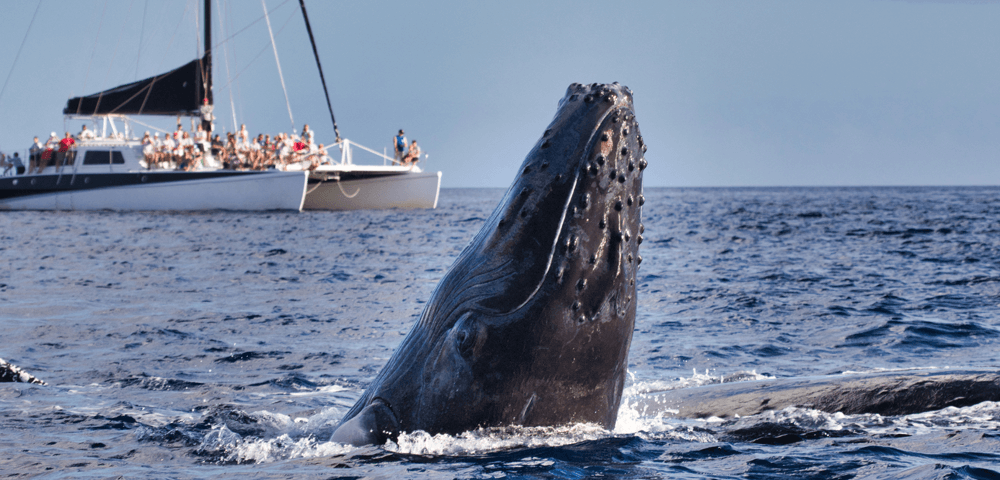Whale watching in Cabo San Lucas is a magical experience, attracting visitors from all over the world. The waters of the Baja California Peninsula act as a nursery for several whale species. These magnificent creatures use this area as breeding grounds and a place to raise their young.
Between December and April, Cabo transforms into a premier destination for people to witness some of the largest animals on the planet. Here are six types of whales in Cabo that you might encounter If you venture out on a whale-watching tour.
Humpback Whale
Humpbacks are the most frequently spotted whale in Cabo. These friendly and curious creatures are famous for their migratory acrobatic displays. They are easily recognizable with their long pectoral fins and knobby heads. Each humpback whale has a distinctive imprint on its tail fluke, not unlike a human fingerprint. They can grow to lengths of up to 50 feet and weigh around 40 tons.
Male humpbacks sing intricate songs to communicate with other whales and attract mates. These songs can last hours and travel long distances underwater. Humpbacks are also playful by nature, often breaching out of the water and slapping their tails or fins on the surface. Usually accompanied by loud exhalations, these actions are spectacular to witness in person.
Their calves, born in the warm waters of Cabo, are around 15 feet long and weigh over 2 tons at birth. Humpbacks are social creatures and often travel in small pods. During a whale-watching tour, you may even witness a mother teaching her calf to breach the surface or a group of humpbacks competing in playful splashes.
The humpback whale’s migration brings it to Cabo from the cold waters of the northern Pacific and Alaska. They arrive around December and stay until April, offering ample opportunities for sightings. You can observe them from the shore or, for a closer look, embark on a whale-watching tour.
Gray Whale
The gray whale is another species found off Cabo’s coast. These whales undertake one of the longest migration routes of any mammal, traveling over 10,000 miles each year from their feeding grounds in the cold waters of the Bering Sea to their breeding grounds in Baja California, including Magdalena Bay, just north of Cabo San Lucas. Gray whales are typically seen between January and April, though they are sometimes spotted earlier or later in the season.
Unlike other whale species, gray whales are often quite curious. It is not uncommon to witness them approaching boats, especially their calves. These whales can grow up to 49 feet in length and weigh around 40 tons. They are recognizable by their mottled gray skin and the presence of barnacles and parasites that cling to their bodies. These creatures are more likely to be seen during close encounters, with gray whale calves often peeking at boats and humans.
While the best places to observe gray whales are north of Cabo, you can still glimpse them as they pass through the Sea of Cortez. Their gentle nature and curiosity make them a favorite among whale watchers.
Blue Whale
The blue whale is the largest animal to have ever lived on Earth. The heart of a blue whale can weigh as much as 400 pounds, the biggest of any living creature. They are also the loudest animals in the world. Their mating calls can be as loud as 188 decibels- noisier than a grenade going off. Despite their size, they are nimble and elegant swimmers.
These gentle giants can reach lengths of up to 100 feet and weigh as much as 200 tons. They are often spotted in the deep waters surrounding Cabo between January and March, although they are rarer than the humpback or gray whales.
Blue whales have a distinctive blue-gray coloration that is harder to see from a distance, which makes spotting them more challenging. However, their sheer size and massive blows of air, often reaching heights of 30 feet, make them impossible to miss once they surface. Despite their size, blue whales are filter feeders, consuming tiny organisms like krill, which they take in through their baleen. During the feeding season, they can consume up to 4 tons of krill daily.
Blue whales migrate to Cabo’s warm waters each winter, where they typically give birth and nurture their young. Given their size and migratory patterns, blue whales tend to stay further offshore, but with the right conditions, you may have a chance to spot one during a whale-watching tour.
Fin Whale
The fin whale is the second-largest whale species in the world. They can grow up to 80 feet in length and weigh as much as 80 tons. Fin whales are sleek, streamlined animals built for speed. They can be identified by their asymmetrical coloring, with a pale right side and a darker left side. These whales are often mistaken for blue whales due to their similar size, but their speed and distinctive pigmentation set them apart.
Fin whales are migratory creatures that visit the waters around Cabo San Lucas during the winter months. You can spot them from December to April, and while sightings are less common than the humpback or gray whale, fin whales are still present in the region. Their blows are less dramatic than other whales, but their powerful tails and sleek bodies cutting through the water make for a stunning display.
They are less social than other species, often preferring to travel alone or in small groups, making sightings rarer. However, their speed and grace in the water make them one of the most impressive species to witness while whale watching in Cabo.
Sperm Whale
The sperm whale is another fascinating species spotted in Cabo’s waters. These whales are notable for their massive, square-shaped heads, which make up nearly a third of their body length. They are the largest of the toothed whales and can grow up to 52 feet in length and weigh as much as 57 tons. Unlike the baleen whales, sperm whales hunt squid, including the giant squid, in deep waters.
Although sperm whales are typically found farther offshore, they can occasionally be seen in Cabo’s waters. You can find them year-round, although sightings are less frequent during peak whale-watching season. One of the most impressive things about sperm whales is their deep-diving ability. They can dive to depths of over 10,000 feet in search of food, making them one of the most specialized deep-sea hunters in the world.
Their long, deep dives mean they spend more time underwater than other whale species. When they breach the surface, their powerful blows and large heads make them easy to identify. Their solitary nature means they are often alone, but you may encounter them in a group, especially during their feeding times.
Killer Whale (Orca)
Orcas are among the most recognizable marine species, known for their striking black-and-white coloration. Orcas are actually dolphins, but their size and behavior have earned them the nickname “killer whale.” These apex predators are highly social and are often seen in pods, working together to hunt fish, seals, and even large whales. Orcas can grow up to 32 feet long and weigh over 22,000 pounds.
While not as commonly spotted as other whale species, their presence in the waters around Cabo San Lucas is not unheard of. They can be spotted in the Sea of Cortez, particularly around La Ventana and Jacques Cousteau Island. Orcas are highly intelligent, and their pod structures allow them to coordinate complex hunting techniques, which can be fascinating to observe.
If you are fortunate enough to spot a pod of orcas during your whale-watching tour, you will witness some of the ocean’s most impressive behavior. These whales often hunt in groups, coordinating their movements to catch prey efficiently. Their playfulness and sharp hunting skills make orcas one of the most thrilling species to encounter on a whale-watching tour.
Cabo Sailing’s Premier Whale-Watching Tours: Private Yachts and Shared Sails Options
At Cabo Sailing, we go above and beyond to ensure that your whale-watching experience is one you will never forget. With over 18 years of experience in the area, we know exactly where and when to take you to see the whales in Cabo. We operate with a fleet of luxury yachts and sailing vessels, offering private and shared sailing options for a more intimate experience.
Our private yacht charters are the perfect choice for those who want to explore Cabo’s waters in style and comfort. We tailor each tour to your preferences, allowing you to enjoy the experience exactly as you wish. Our professional crew will provide insight into the whales’ behaviors, migration patterns, and other marine life in the area, making your whale-watching tour informative and unforgettable.
If you prefer a more social experience, our shared sailing tours offer a unique way to meet fellow travelers while still enjoying the luxury and comfort of a small, intimate group. Every tour is designed to maximize your chance of seeing these majestic creatures up close.




